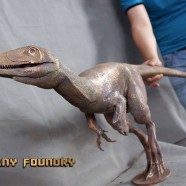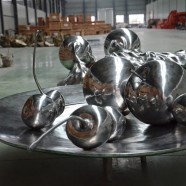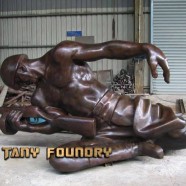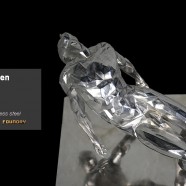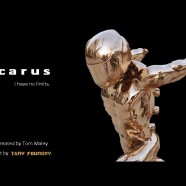4 Ways 3D Tech Can Help Sculptors
As the pioneering art foundry in China exploring help to apply 3D tech to help sculptors create works. we’d like to share a few of our thoughts. (1) Pre-Visualization Compared with traditional clay modeling, 3D modeling can quickly visualize your ideas. It is very useful in you design phase when you want to modify your model or make a series variation of a piece of sculpture. (2) Integrate 3D Tech with Art Foundry process The traditional process of clay modeling – bronze casting is been taken place by 3D scanning/ printing- bronze casting process. It is not only faster but also more economical. (3) 3D Scan your original work for virtual exhibition. By 3D scanning your own work, you can exhibit it anywhere around world without physically sending off the piece to a place. 3D virtual exhibition can greatly boost the influence your works and make the collectors know your sculptures much better than 2D images. (4) 3D Scanning Help Restore Old Sculpture By 3D scanning your own sculptures, you can reserve its 3D image permanently, which can be use to maintain the sculpture after a few years. This tech is extremely helpful to save the old sculptures. Below are a few works we produce by integrating 3D tech with metal casting. I’d like to hear your opinions on how 3D tech has change the way you create artworks. Please contact us. ...
Read MoreEaster Bunny Sculpturatural Project
A man’s limit is his own limitation. With the help of artist’s talent, amazing artworks can be created. Tany Foundry is so honored to collaborate with artist Brigita and Sandis to produce a wonderful Easter Bunny aluminum cast sculpture, which consists of a big bunny, lots of vegetables and fruits. The bunny sculpture is 7.5 feet tall. We combine lost wax casting with lost wax casting to maximize the best possible artistic appearance. Then we highly polished the sculpture pieces. Below is are photo documentation showing how we make it. Here is the rendering drawing of the sculpture. We make the patterns of the sculptures. We cast aluminum and are chasing them. It is very difficult to cast some of the fruits becuase there are thin. We combine lost wax casting and sand casting to succsffuly make them. After very careful chasing and cleaning the aluminum casting, we move on polishing. We employ three step polishing system to polish all the pieces. The result is stunning. Here are a few photos showing the finished works. We use 24K gold leaf for gilding the Easter bunny. The textures of the rabbit is wrinkle like and we keep all the textures carefully. The gold gilt sculpture looks really beautiful. Feel free to let me know if you have any technical question for this or your own project. Please click the button below if you need an estimate for your own...
Read More3 Tips to Achieve High Quality Polished Sculpture
Tany Foundry has been working hard to test different approaches to achieve high quality polished finishing on bronze and stainless steel cast sculptures. We’d like to introduce three proven effective tips to artists on how we polish on sculptures. Tip 1: Chasing and finishing bronze casting very carefully. The quality of chasing is closely related to the final quality on polished finishing. Therefore, every imperfection has to be fixed; every pinhole has to be filled. The surface before polishing has to be very smooth and consistent. Good quality casting is the foundation for nice polishing. One thing worth noting is that unlike stainless steel fabrication , it is difficult to achieve mirror polishing finishing on stainless steel casting. Tip 2: Choosing polishing tools carefully. We employ multiple step polishing approach. For the preliminary polishing process, we use rough polishing wheel then proceed to use finer polishing material. Use while polishing compound first, when use green compound. Above: polishing compound: green and white. Above: Polishing wheel Tips 3: Control the temperature of the casting when polishing. Polishing process will generate large amount of heat, which should be avoided as it will burn the surface of the metal and lower the polishing quality. It is a good idea to use fan or water cooling system to coll down the surface of metal when polishing. Feel free to contact us if you have any technical question of your own project. We offer free technical consultancy to...
Read MorePolished Stainless steel Sculpture We Cast
Stainless steel cast sculpture looks really beautiful and intriguing if done well. However, duo to its extremely high melting temperature (1800 degree Celsius) and tough chasing & finishing process, it is much more difficult to cast stainless steel than cast bronze. There are types of stainless steel for casting sculptures options: stainless steel Grade 201, stainless steel Grade 316, stainless steel Grade 316L. We can cast all of them. However, we recommend stainless steel 316 for sculpture as it is marine grade alloy, featuring superior corrosion resistance performance even in salty water. Below is a stainless steel sculpture we recently cast. We cast with stainless steel Grade 316 and polish it a little bit to make it shiny. Here is our work flow. Step One: Making the pattern. We use modern 3D printing technology to make the pattern from a digital model our client provides us. Step Two: Making silicon rubber mold Step Three: Make Wax Step Four: Cast stainless steel and polish Feel free to contact us if you need an inquiry of your own project....
Read MoreHow to Integrate 3D Printing with Bronze casting for sculpture
3D Printing is on its way to revolutionize how sculptors works. Tany Foundry is the first fine art foundry in China exploring how to employ 3D printing technique into bronze casting. In this short tutorial, I am going to show you how and why 3D Printing is helpful to create sculptures, even for “traditional sculptors”. Also, I will use a project we recently accomplished to show you the process step by step. Step 1: Creating 3D model Overall, there are two ways to create 3D model. 3D Scanning Digital Modelling 3D Scanning Digital Modelling Use 3D laser scanner to scan the physical object to generate a digital model of the sculpture. If you’ve already sculpted a sculpture maquette, you can have it 3D scanned it. The scanned model has to be refined and remodeled before 3D Printing. Below is a photo of the 3D Scanner we use for scanning.It is a four lens scanner with scanning accuracy 0.015MM. Use computer software to create the digital model virtually. The commonly used software are 3D Max, Maya, Zbrush, Rhino. The biggest benefit of using 3D printing to create sculpture is what it allows you the maximum flexity and freedom to make your works without needing to worry about cost and time. It is much easier to modify a sculpture than on clay. Besides, it costs less, both in time and money. Four lens 3D scanner we use for scanning objects, which features high scanning accuracy and speed. Above are the most often used 3D modelling software. In another tutorial, I am going to demonstrate how to choose the right software. This is the digital model of the sculpture, which is for us to 3D print and cast bronze. The artist creates the digital model by 3D scanning his maquette. Step 2: 3D Printing There are a few options of 3D Printings. Below are some of the most commonly used, which are chosen based on the size and printing of your sculpture. 3DP : Used for small sized object. It can be useful when you need your sculptures to be printed in color. MEM: It features high strength and low cost. The accuracy is not very high. SLS: It can print out different material, even metal. SLA: It is useful for small sized works. Accuracy is acceptable. After data processing, we 3D print out the digital model. We choose the High Definition mode to make the surface of the sculpture smooth. Please note, even printing with the most advanced printer, the surface of the sculpture has to be sanded and smoothened. For some low end 3D printer, there will be lots of layered line left on the surface so you need to make sure to sand it completely. We suggest using very fine sand paper for sanding the 3D print. The sand paper we use #1000 and #2000. Step 3: Molding We make rubber mold as well as wax mould from the 3D print. It is important to compare the wax with the 3D as well as the original digital model very carefully and retouch the wax if necessary. There are two options for bronze casting: lost wax casting and sand casting. Since most of 3D print is small in size, we use lost wax casting technique in most cases. Step 4: Bronze casting Just like on wax, the finished bronze casting has to be compared with the 3D print thoroughly and refined if necessary. If you have any technique question about how to apply 3D printing to sculpting or need a quote for your own work,Please...
Read More
